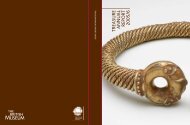Treasure Annual Report 1998-1999 - Portable Antiquities Scheme
Treasure Annual Report 1998-1999 - Portable Antiquities Scheme
Treasure Annual Report 1998-1999 - Portable Antiquities Scheme
Create successful ePaper yourself
Turn your PDF publications into a flip-book with our unique Google optimized e-Paper software.
Circumstances of discovery: While searching with a<br />
metal-detector.<br />
Description: The rings are somewhat crushed and<br />
distorted (and one is slightly split), thus difficult to<br />
measure accurately. Ring (a) (split) – width of band 14<br />
mm. Ring (b) – width of band 13 mm. The maximum<br />
thickness at the flattened edges is 1 mm; the diameter<br />
is not measurable but should not exceed 32 mm.<br />
The two linked rings are of ribbon section, each<br />
having one end tapering to a rectangular-sectioned<br />
hook to pass through a circular perforation in the<br />
other end, also tapered. The edges are flattened. Ring<br />
(a) has a small split; (b) has some abrasion, probably<br />
recent. Size and pairing suggests that these might<br />
have been ear ornaments. Combined weight: 8.61g.<br />
The rings can be accommodated within a Middle<br />
Bronze Age tradition of gold working with good<br />
analogues in France which have been dated to about<br />
1500–1300 BC. The scientific analysis accords well<br />
with such a date.<br />
Note: Approximately 85 per cent for gold. See<br />
<strong>Treasure</strong> <strong>Annual</strong> <strong>Report</strong> 1997–98, no. 15.<br />
Disposition: Littlehampton Museum<br />
Valuation: £800<br />
(fig.3) Binstead<br />
G VARNDELL<br />
4 Haughton, Nottinghamshire: Middle Bronze Age<br />
gold ring<br />
Date: About 1300–1100 BC<br />
<strong>Treasure</strong> <strong>Annual</strong> <strong>Report</strong> <strong>1998</strong> - <strong>1999</strong> 11<br />
Prehistoric Artefacts<br />
Finder: Mr Robert Johnson<br />
Date of discovery: May <strong>1998</strong><br />
Circumstances of discovery: While searching with a<br />
metal-detector.<br />
Description: Three hollow-backed penannular rings<br />
set side by side, creating three bulbous ribs. Maximum<br />
diameter: 18 mm; width: 10 mm; weight: 7.1g.<br />
Note: Not analysed. See <strong>Treasure</strong> <strong>Annual</strong> <strong>Report</strong><br />
1997–98, no. 14.<br />
Disposition: Found not to be <strong>Treasure</strong>; returned to<br />
finder.<br />
M J DOLBY<br />
5 Lower Langford, Somerset: Middle Bronze Age<br />
gold penannular ring<br />
(Fig. 5)<br />
Date: About 1300–1100 BC<br />
Finder: Mr Ted Chaffey<br />
Date of discovery: Early–mid <strong>1998</strong><br />
Circumstances of discovery: While searching with a<br />
metal-detector.<br />
Description: The object is in fact two penannular<br />
rings fused or soldered together side by side. Each<br />
ring is near circular in cross-section. Careful<br />
inspection of the surface reveals folds and crimps in<br />
the gold and traces of copper-alloy corrosion at<br />
fissures. These indicate that the rings are of gold foil<br />
covering presumed base-metal cores. The object<br />
belongs to an established type of Bronze Age<br />
ornament known as ‘composite rings’.<br />
Dimensions: Maximum diameter: 15 mm; weight: 5.2g.<br />
Note: Approximately 81 per cent for gold.<br />
Disposition: Awaiting valuation; North Somerset<br />
Museums Service hopes to acquire.<br />
S P NEEDHAM<br />
6 Braishfield, Hampshire: Middle Bronze Age gold ring<br />
(Fig. 6)<br />
Date: About 1300–1100 BC<br />
Finder: Mr D Palmer





